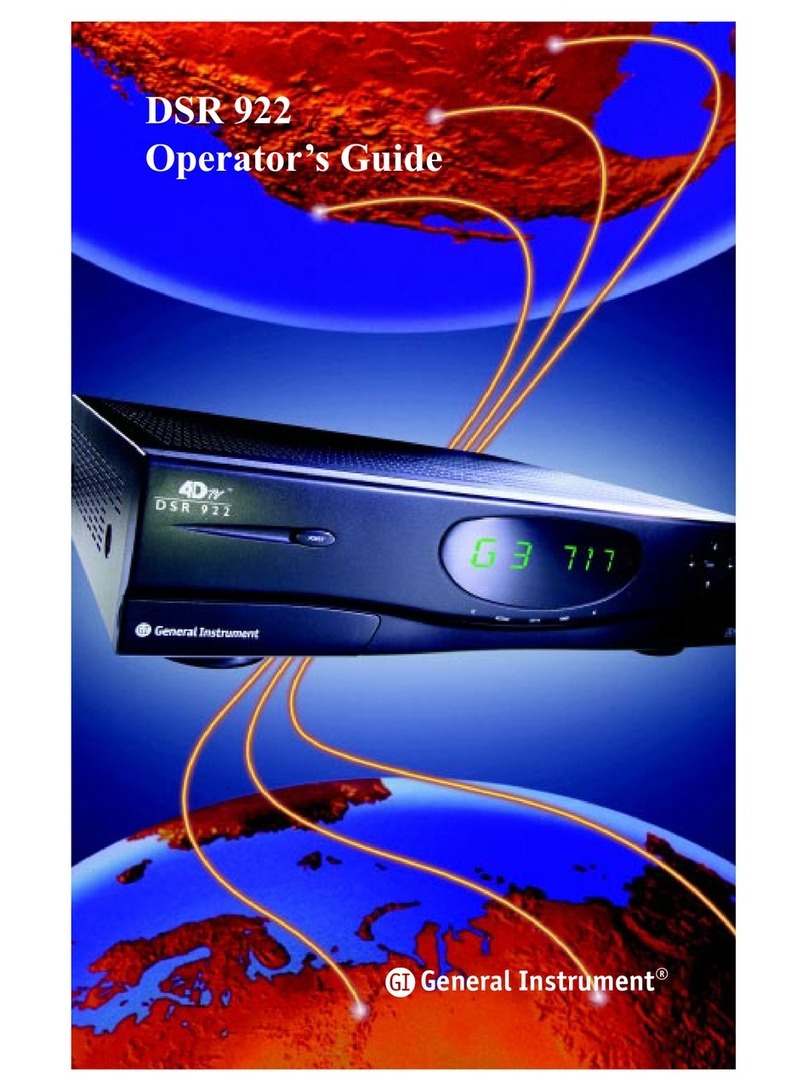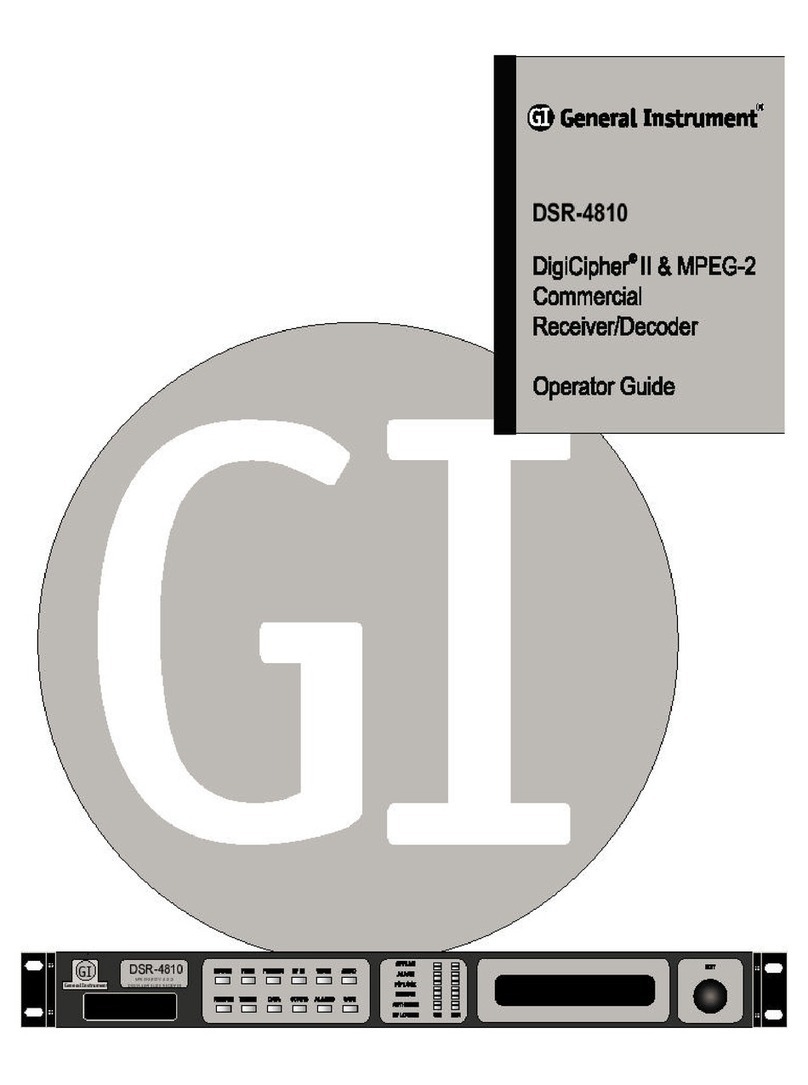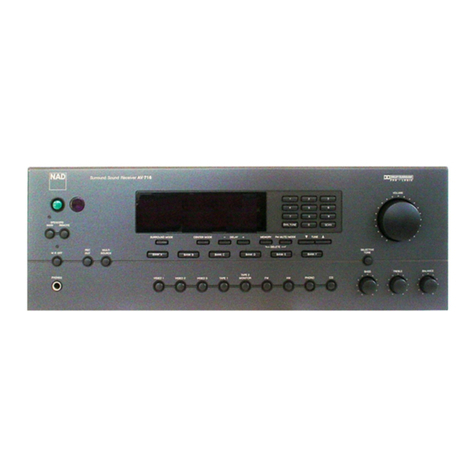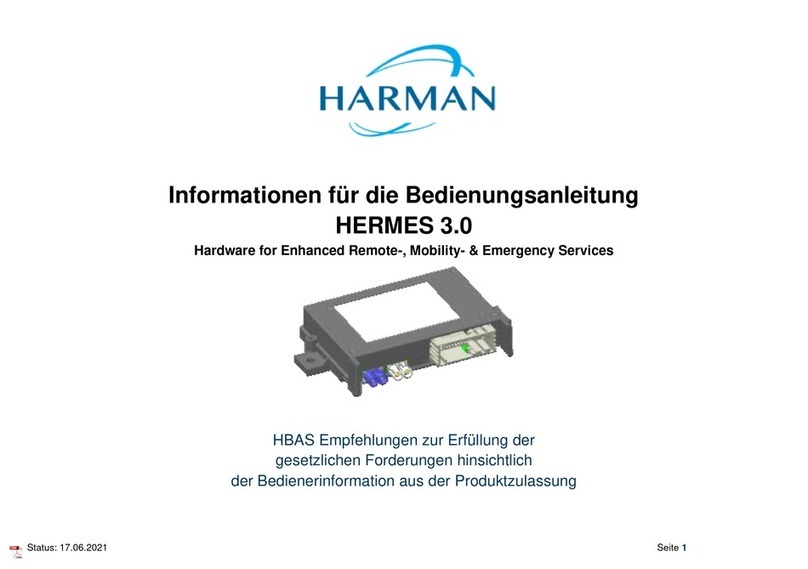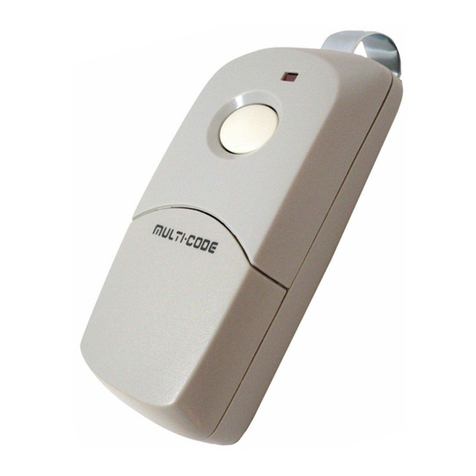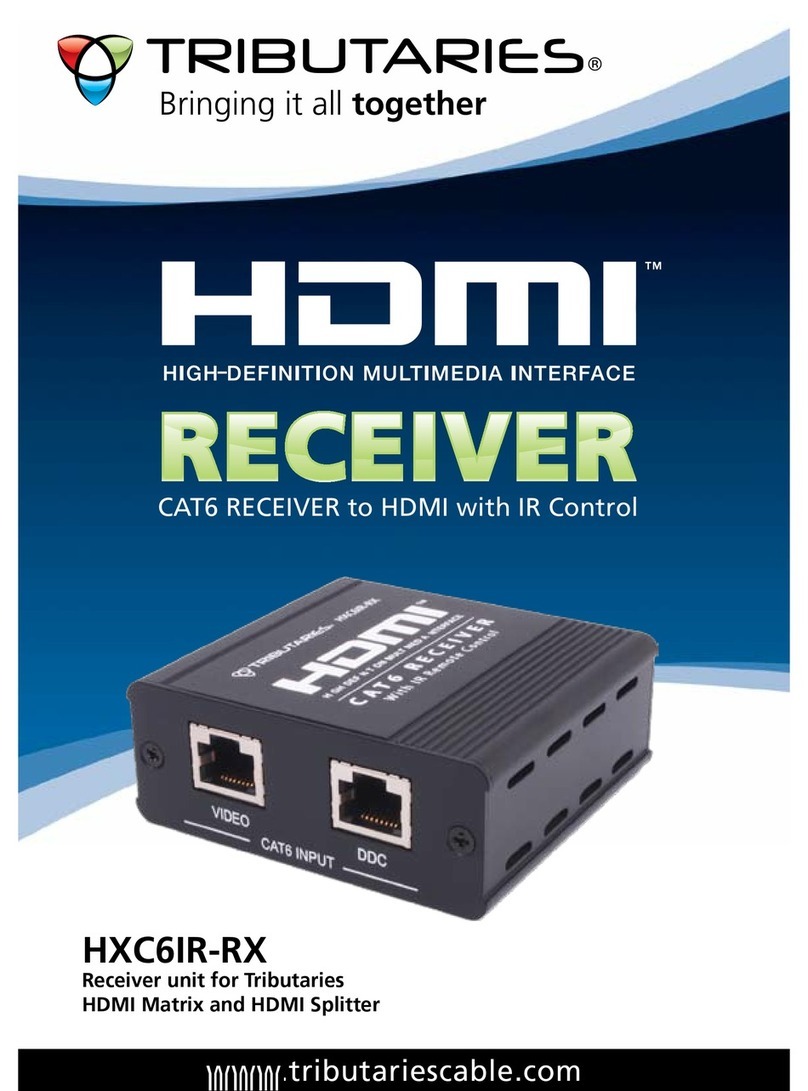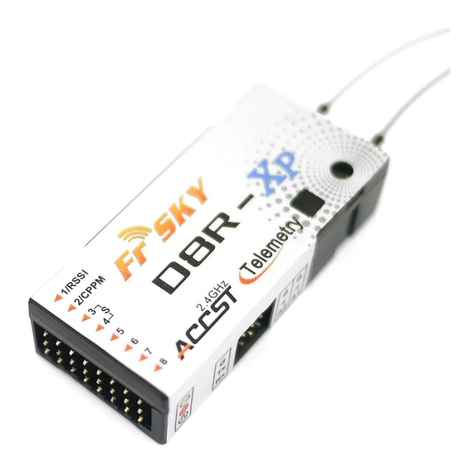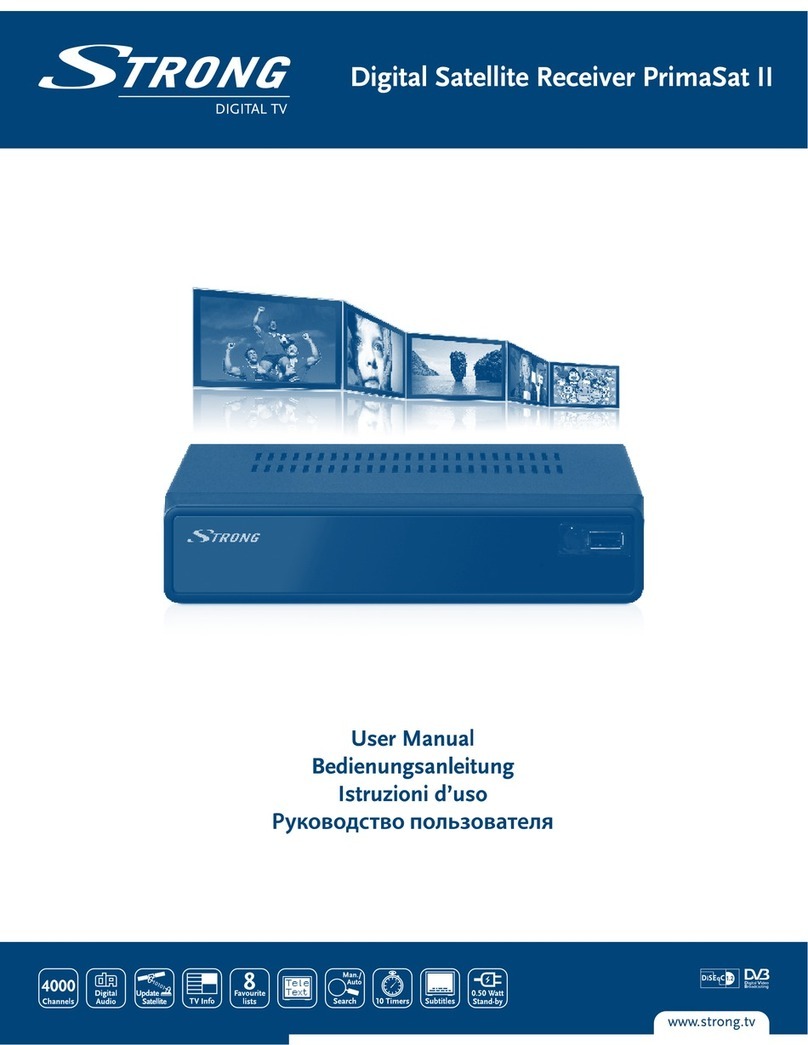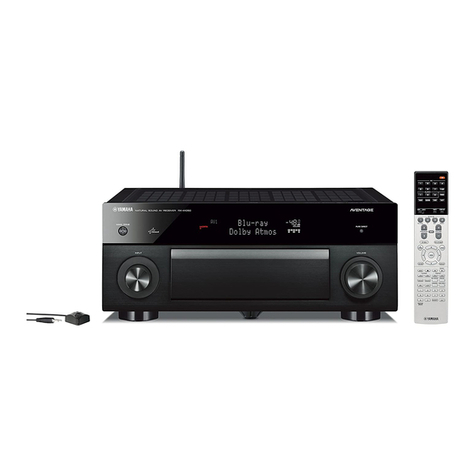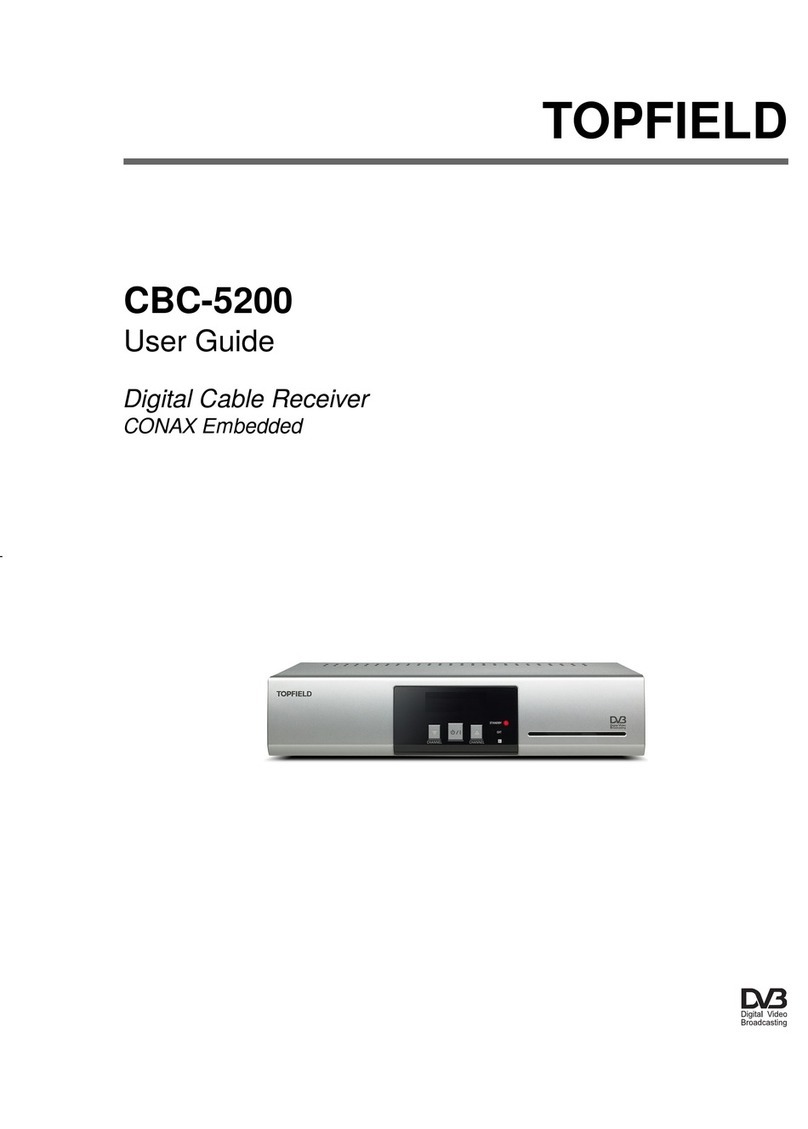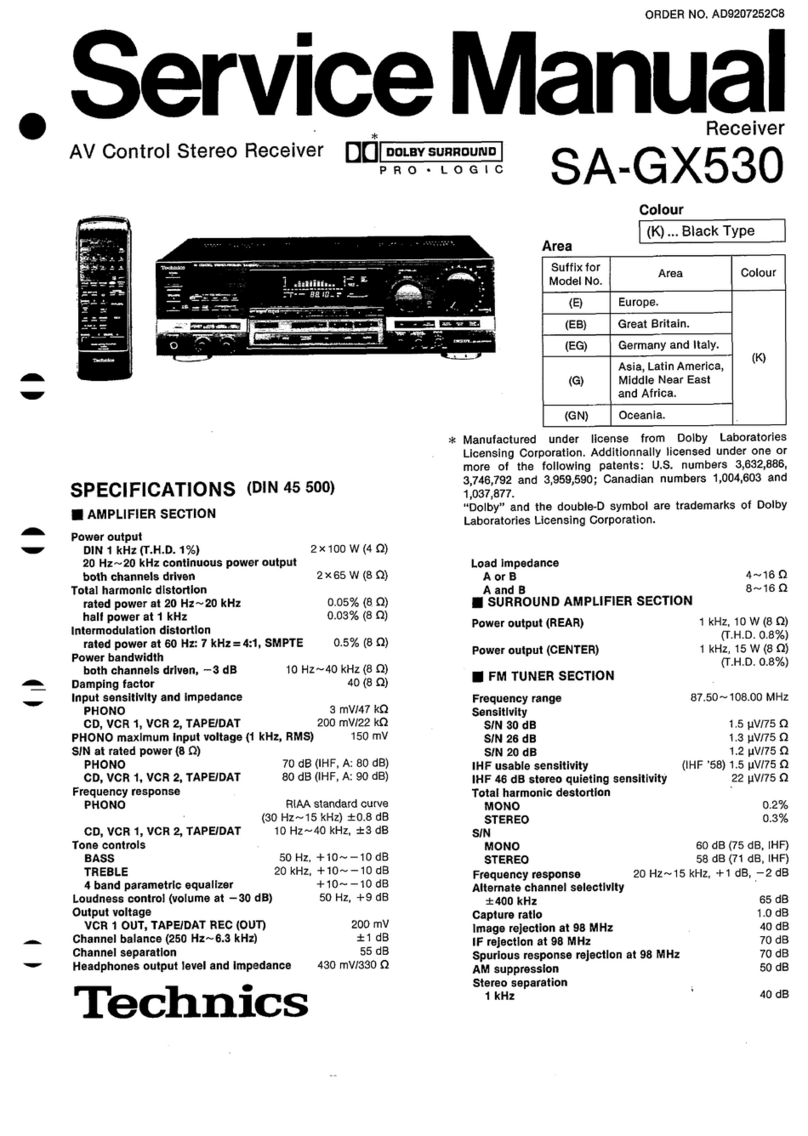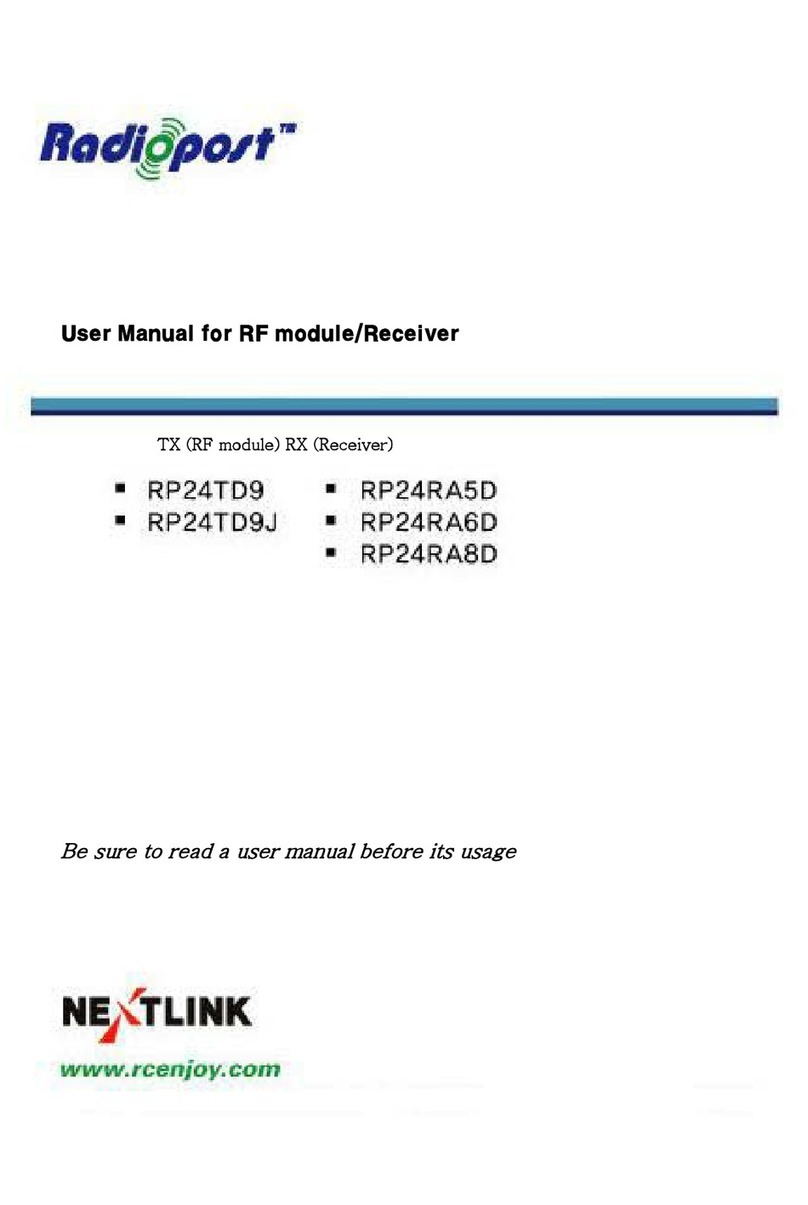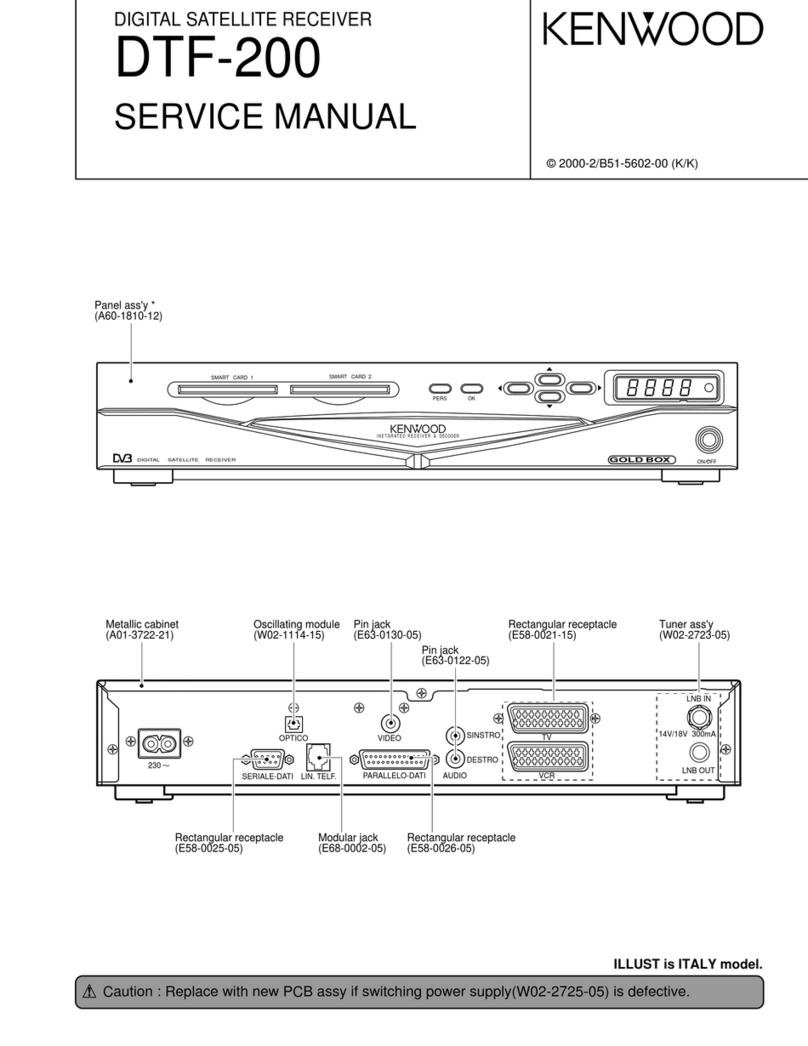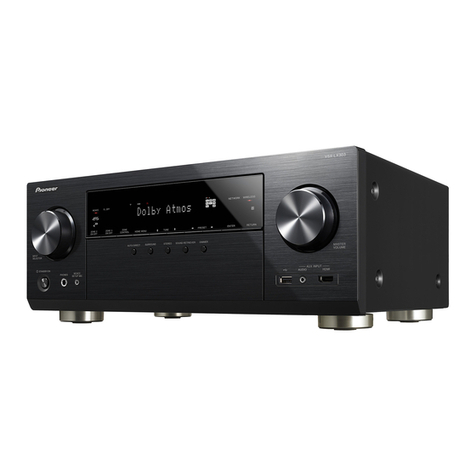General Instrument DSR-4810 User manual

..........
.
.
.
.
.
.
.
.
.
.
CBS/UPN Television Networks
Integrated Receiver-
Decoder
User’s Guide
IRD Description and Configuration
From The CBS Digital Affiliate Rack User’s Guide, byCBS Engineering
Rev. 1.4, 6/19/2002

IRD User Guide i
Foreword
This document is intended for use by those affiliates, business partners, and
clients of CBS/UPN who will use the General Instrument DSR-4800 series IRD
as a standalone digital satellite receiver to acquire the CBS or UPN programming
appropriate to the respective business relationship with CBS/UPN. Most
standalone sites will be equipped with the DSR-4800, which is the base GI
4:2:2P@ML DCII+ IRD. Some will be equipped with the DSR-4810, which offers
special video reference features not needed in most applications. Users of the
DSR-4800 may disregard those sections on the Video Menu, which refer to the
BBG output and reference inputs, as they will not apply to that model.
This is a guide that provides the user with general information, which will assist
the user in understanding the technology, its application by CBS/UPN, and to
configure the unit for use on the CBS and UPN distribution network. This guide
is not intended as a substitute for the equipment operator guide provided by
General Instrument, but as a supplement. The user should first become familiar
with the GI DSR-4810 Operator Guide and then consult this document.
Please note that for proper operation, your receive system must be equipped
with LNB’s appropriate for the reception of digital signals. Such LNB’s are readily
available and relatively inexpensive. CBS/UPN is not officially endorsing it, but
the California Amplifier Model 140194 LNB or equivalent is suitable. Please
ensure that the minimum receive system requirements are met in order to ensure
maximum signal availability. Refer to Table 11 for IRD RF performance and input
requirement data.
If further assistance is required, contact:
Rob Goldfarb, CBS Affiliate Engineering
212.975.1815
rsgoldfarb@cbs.com
Dave Chilson, Associate Director, Broadcast Distribution Services
212.975.4077
dachilson@cbs.com

IRD User Guide ii
Table of Contents
Virtual Channels, Virtual Channel Tables, & Virtual Channel Maps .................................................... 1
MPEG Service/Program Number ........................................................................................................... 1
Menu Editing Procedure......................................................................................................................... 3
Program and RF Menus (DCII-Manual Mode) ...................................................................................... 4
Program Menu (DCII-VCT Mode).......................................................................................................... 7
RF Menu (DCII-VCT Mode)................................................................................................................... 8
Status Menu ............................................................................................................................................ 9
Video Menu (Configurable) .................................................................................................................. 10
Audio Menu (Configurable).................................................................................................................. 12
Remote Menu (Configurable)................................................................................................................ 15
Alarms Menu (Configurable)................................................................................................................ 16
Presets Menu......................................................................................................................................... 18
Timers Menu ......................................................................................................................................... 18
Data Menu ............................................................................................................................................ 18
Config Menu ......................................................................................................................................... 18
Save Menu............................................................................................................................................. 18
LIST OF TABLES
TABLE 1: CBS/UPN 241 T6/T4 NOMINAL OPERATIONS VIRTUAL CHANNEL TABLE ..................................... 2
TABLE 2: CBS/UPN 242 T5/T4 TELSTAR 6 RECOVERY VIRTUAL CHANNEL TABLE ...................................... 2
TABLE 3: CBS 243 T6/T5 TELSTAR 4 RECOVERY VIRTUAL CHANNEL TABLE ............................................... 3
TABLE 4: IRD VIRTUAL CHANNEL INITIALIZATION ....................................................................................... 5
TABLE 5: IRD RF ASSIGNMENT/CONFIGURATION ......................................................................................... 6
TABLE 6: IRD VIRTUAL CHANNEL NOMINAL OPERATION CONFIGURATION.................................................. 7
TABLE 7: IRD AUDIO CODING MODE........................................................................................................... 13
TABLE 8: IRD LANGUAGE CODE.................................................................................................................. 13
TABLE 9: IRD AUDIO CONFIGURATION........................................................................................................ 15
TABLE 11: IRD C-BAND TO L-BAND CONVERSION RECOMMENDATIONS..................................................... 19

IRD User Guide 1
General Instrument DSR-4810 Integrated Receiver / Decoder (IRD)
Virtual Channels, Virtual Channel Tables, & Virtual Channel Maps
The GI IRD's do not refer to RF channels in the same sense as tuning to a particular
transponder “channel” with an analog receiver. IRDs use Virtual Channels. A Virtual
Channel (VC) is essentially a pre-configured IRD control setting. When a virtual channel
number is selected; RF tuning, demodulation, and decoding settings, unique to the selected
VC, is automatically entered into the IRD. A Virtual Channel Table (VCT) is a list or
grouping of virtual channels. Table 1 illustrates VCT 241, which is the nominal virtual
channel table for daily operations of the CBS and UPN Television Networks. Table 2
illustrates VCT 242, which is the virtual channel table that would be used in the event that the
Telstar 6 satellite fails and is replaced by Telstar 51. It also includes restoration plan
transponders for Telstar 4 restorations in the event of a transponder failure. Likewise, Table 3
illustrates VCT 243, which is the virtual channel table that would be used in the event that the
Telstar 4 satellite fails and is replaced by Telstar 52. It also includes restoration plan
transponders for Telstar 6 restorations in the event of a transponder failure. Note that
although the VC’s are selected by number, they are operationally referred to by name, as
defined in the VCT and displayed on the IRD itself.
It can be seen from viewing Table 1 that variables such as satellite, transponder, carrier
frequency, polarization, modulation scheme, transport type, and MPEG stream service
number are automatically entered into the IRD when a virtual channel number is selected. A
Virtual Channel Map is a Virtual Channel Table; but more specifically refers to the tuning,
demod, and decode settings that are “mapped” or linked to the particular Virtual Channel. The
words Virtual Channel Table (VCT) and Virtual Channel Map (VCM) are generally used
synonymously.
The satellite and polarization information actually tell the IRD which of its four RF inputs to
use. In a separate IRD initialization process, the IRD is programmed by the user as to which
satellites and polarizations can be found on its four RF inputs. Therefore when a VC is
selected and the VC map contains one of the four possible satellite/polarization combinations,
the IRD will switch to the appropriate RF input.
MPEG Service/Program Number
After carefully viewing Table 1, it should become evident that VCT 241, which is comprised
of 30 virtual channels, is really a listing of ten, 3-virtual channel groups. VC #1 through VC
#3 contain almost identical virtual channel map data. The same can be said for VC #4
through VC #6 as well as VC #7 through VC #9, and so on. The RF tuning and demodulation
settings within each three VC group are identical. Each of the VCs within a three VC group
is, in essence, receiving the exact same satellite digital signal. The only parameter that
changes within each of the three VC groups is the service number and the source name
displayed on the IRD. This service number refers to the MPEG service or program number.
Within each received satellite signal, are three MPEG-2 compressed programs multiplexed
into the demodulated digital data stream. Therefore, for example, although VC #1, VC #2,
and VC #3 are each receiving the exact same satellite signal, each of them extracts or
demultiplexes a different MPEG program from the data stream. This is due to the fact that
VC #1, VC #2, and VC #3 each have a different MPEG service number.
1If Telstar 6 is replaced by Telstar 5, the IRD RF configuration for Antenna Inputs 1 and 2 must have
the Satellite ID number changed from 55 to 19. See “Program and RF Menus (DCII-Manual Mode)”
section.
2If Telstar 4 is replaced by Telstar 5, the IRD RF configuration for Antenna Inputs 3 and 4 must have
the Satellite ID number changed from 12 to 19. See “Program and RF Menus (DCII-Manual Mode)”
section.

IRD User Guide 2
Transport Displayed Service Carrier FEC Modulation Symbol
V
CN Type Source Name Transponder Satellite Number Frequenc
y
POL Rate Scheme Rate (kHz)
1 MPEG-2 T6_20A_EAST 20 55 1 4100 H 3/4 QPSK 29265.7
2 MPEG-2 T6_20B_PAC 20 55 2 4100 H 3/4 QPSK 29265.7
3 MPEG-2 T6_20C 20 55 3 4100 H 3/4 QPSK 29265.7
4 MPEG-2 T6_23A 23 55 4 4160 V 3/4 QPSK 29265.7
5 MPEG-2 T6_23B 23 55 5 4160 V 3/4 QPSK 29265.7
6 MPEG-2 T6_23C 23 55 6 4160 V 3/4 QPSK 29265.7
7 MPEG-2 T6_22A 22 55 7 4140 H 3/4 QPSK 29265.7
8 MPEG-2 T6_22B 22 55 8 4140 H 3/4 QPSK 29265.7
9 MPEG-2 T6_22C 22 55 9 4140 H 3/4 QPSK 29265.7
10 MPEG-2 T4_13A_EAST 13 12 10 3960 V 3/4 QPSK 29265.7
11 MPEG-2 T4_13B_PAC 13 12 11 3960 V 3/4 QPSK 29265.7
12 MPEG-2 T4_13C 13 12 12 3960 V 3/4 QPSK 29265.7
21 MPEG-2 T6_14A_EAST 14 55 1 3980 H 3/4 QPSK 29265.7
22 MPEG-2 T6_14B_PAC 14 55 2 3980 H 3/4 QPSK 29265.7
23 MPEG-2 T6_14C 14 55 3 3980 H 3/4 QPSK 29265.7
24 MPEG-2 T6_12A 12 55 4 3940 H 3/4 QPSK 29265.7
25 MPEG-2 T6_12B 12 55 5 3940 H 3/4 QPSK 29265.7
26 MPEG-2 T6_12C 12 55 6 3940 H 3/4 QPSK 29265.7
27 MPEG-2 T6_9A 9 55 7 3880 V 3/4 QPSK 29265.7
28 MPEG-2 T6_9B 9 55 8 3880 V 3/4 QPSK 29265.7
29 MPEG-2 T6_9C 9 55 9 3880 V 3/4 QPSK 29265.7
30 MPEG-2 T4_19A_EAST 19 12 10 4080 V 3/4 QPSK 29265.7
31 MPEG-2 T4_19B_PAC 19 12 11 4080 V 3/4 QPSK 29265.7
32 MPEG-2 T4_19C 19 12 12 4080 V 3/4 QPSK 29265.7
33 MPEG-2 T4_11A 11 12 12 3920 V 3/4 QPSK 29265.7
34 MPEG-2 T4_11B 11 12 12 3920 V 3/4 QPSK 29265.7
35 MPEG-2 T4_11C 11 12 12 3920 V 3/4 QPSK 29265.7
36 MPEG-2 T4_10A 10 12 12 3900 H 3/4 QPSK 29265.7
37 MPEG-2 T4_10B 10 12 12 3900 H 3/4 QPSK 29265.7
Table 1: CBS/UPN 241 T6/T4 Nominal Operations Virtual Channel Table
Transport Displayed Service Carrier FEC Modulation Symbol
V
CN Type Source Name Transponder Satellite Number Frequenc
y
POL Rate Scheme Rate (Hz)
1 MPEG-2 T5_6A_EAST 6 19 1 3820 H 3/4 QPSK 29265.700
2 MPEG-2 T5_6B_PAC 6 19 2 3820 H 3/4 QPSK 29265.700
3 MPEG-2 T5_6C 6 19 3 3820 H 3/4 QPSK 29265.700
4 MPEG-2 T5_19A 19 19 4 4080 V 3/4 QPSK 29265.700
5 MPEG-2 T5_19B 19 19 5 4080 V 3/4 QPSK 29265.700
6 MPEG-2 T5_19C 19 19 6 4080 V 3/4 QPSK 29265.700
7 MPEG-2 T5_21A 21 19 7 4120 V 3/4 QPSK 29265.700
8 MPEG-2 T5_21B 21 19 8 4120 V 3/4 QPSK 29265.700
9 MPEG-2 T5_21C 21 19 9 4120 V 3/4 QPSK 29265.700
10 MPEG-2 T4_13A_EAST 13 12 10 3960 V 3/4 QPSK 29265.700
11 MPEG-2 T4_13B_PAC 13 12 11 3960 V 3/4 QPSK 29265.700
12 MPEG-2 T4_13C 13 12 12 3960 V 3/4 QPSK 29265.700
30 MPEG-2 T4_19A_EAST 19 12 10 4080 V 3/4 QPSK 29265.700
31 MPEG-2 T4_19B_PAC 19 12 11 4080 V 3/4 QPSK 29265.700
Table 2: CBS/UPN 242 T5/T4 Telstar 6 Recovery Virtual Channel Table

IRD User Guide 3
Menu Editing Procedure
The IRD possesses 12 menus that display various operational parameters when selected. Six
(6) of the 12 menus have configurable parameters. These configurable menus are Program,
RF In, Video, Audio, Remote, and Alarms. The other non-configurable menus pertain to
Status, Presets, Timers, Data, Configuration, and Save. Each of the 12 menus can be accessed
by depressing the desired menu key within the 12-button menu grouping located on the front
panel. Once depressed, the contents of that menu are displayed on the IRD’s front panel
display and modified (if configurable) using the front panel rotary/push edit selector knob.
The following section describes the menu editing procedure.
1. Press the desired Menu key. The menu name will illuminate above the
selected menu key and the front panel display screen will display the
corresponding field labels.
2. By rotating the Edit knob, move the cursor under the field label that is
to be edited.
3. Press the Edit knob once to enter the edit mode. The word “EDIT”,
located above the Edit Selector knob will illuminate.
4. Rotate the Edit knob to change the data for that particular field.
5. Once the desired setting is displayed within that data field, depress the
Edit knob once to exit the edit mode. This will extinguish the word
“EDIT” above the Edit Selector knob.
6. The Save key, located within the menu key grouping, will now be
illuminated.
Transport Displayed Service Carrier FEC Modulation Symbol
V
CN Type Source Name Transponder Satellite Number Frequenc
y
POL Rate Scheme Rate (Hz)
1 MPEG-2 T6_20A_EAST 20 55 1 4100 H 3/4 QPSK 29265700
2 MPEG-2 T6_20B_PAC 20 55 2 4100 H 3/4 QPSK 29265700
3 MPEG-2 T6_20C 20 55 3 4100 H 3/4 QPSK 29265700
4 MPEG-2 T6_23A 23 55 4 4160 V 3/4 QPSK 29265700
5 MPEG-2 T6_23B 23 55 5 4160 V 3/4 QPSK 29265700
6 MPEG-2 T6_23C 23 55 6 4160 V 3/4 QPSK 29265700
7 MPEG-2 T6_22A 22 55 7 4140 H 3/4 QPSK 29265700
8 MPEG-2 T6_22B 22 55 8 4140 H 3/4 QPSK 29265700
9 MPEG-2 T6_22C 22 55 9 4140 H 3/4 QPSK 29265700
10 MPEG-2 T5_6A_EAST 6 19 10 3820 H 3/4 QPSK 29265700
11 MPEG-2 T5_6B_PAC 6 19 11 3820 H 3/4 QPSK 29265700
12 MPEG-2 T5_6C 6 19 12 3820 H 3/4 QPSK 29265700
21 MPEG-2 T6_14A_EAST 14 55 1 3980 H 3/4 QPSK 29265700
22 MPEG-2 T6_14B_PAC 14 55 2 3980 H 3/4 QPSK 29265700
23 MPEG-2 T6_14C 14 55 3 3980 H 3/4 QPSK 29265700
24 MPEG-2 T6_12A 12 55 4 3940 H 3/4 QPSK 29265700
25 MPEG-2 T6_12B 12 55 5 3940 H 3/4 QPSK 29265700
26 MPEG-2 T6_12C 12 55 6 3940 H 3/4 QPSK 29265700
27 MPEG-2 T6_9A 9 55 7 3880 V 3/4 QPSK 29265700
28 MPEG-2 T6_9B 9 55 8 3880 V 3/4 QPSK 29265700
29 MPEG-2 T6_9C 9 55 9 3880 V 3/4 QPSK 29265700
Table 4: CBS 243 T6/T5 Telstar 4 Recovery Virtual Channel Table

IRD User Guide 4
7. Press the Save key to save the new setting to the IRD’s database. If the
Save key is not pressed within 10 seconds, the new setting will
automatically be saved in the IRD’s database.
To revert to the prior settings, simply press the Status key and the previous settings will
be recalled. This can be done any time during the edit mode, but must be done within 10
seconds after entering the new settings or the IRD will automatically save the newly entered
settings as described in Step 7 above.
Program and RF Menus (DCII-Manual Mode)
The IRD must be placed into DCII Manual mode to receive and demodulate a signal for the
first time. During the time that the IRD is in DCII-Manual mode, selection of the RF menu
permits the entering of the RF configuration parameters3. The inputting of the RF
configuration information is essentially a satellite and signal polarization assignment
procedure; informing the IRD which satellite and signal polarization is assigned to which of
its four RF inputs. After the RF parameters are entered, it is possible to receive the CBS
Network digital satellite signal.
For the DCII VCT (Virtual Channel Table) mode to operate, the IRD must first download the
Virtual Channel Map data via the CBS Network digital satellite transmission system4. The
Virtual Channel Table data acquisition and download takes about 30 seconds to complete
once a RF lock is accomplished. After the Virtual Channel Table is downloaded and the IRD
is placed in DCII VCT mode, the unit will automatically follow the Virtual Channel for all
IRD tuning and decoding settings. All defined VCT’s are downloaded to the IRD
concurrently in the DCII Message Stream.
Initialization
The following IRD “initialization” procedure details the necessary steps for placing the IRD
in DCII-Manual Mode, entering the RF configuration parameters, placing the IRD in DCII-
VCT mode, and downloading the CBS/UPN Virtual Channel Map Tables.
1. Enter the Program Menu by pressing the Prog key once. Referring to Table
5 below, verify the initialization VCT (Virtual Channel Table) and VC
(Virtual Channel) numbers appropriate to the IRD undergoing configuration
within the digital receive system rack, and corresponding to the regional
location of the downlink site5. Use the Edit knob and Save key to make
any necessary adjustments to the Virtual Channel (VC) number. (From left
to right in the VCT data field, the VC number is the four-digit number after
the second colon {:}.)
3If the RF menu were to be selected while the IRD was in DCII-VCT mode, the RF parameters would
simply be displayed and no configuration changes would be allowed.
4VCT (Virtual Channel Table) Mode allows the IRD to download the DCII message stream, which
contains VCT updates and entitlement messages.
5VCT 00000 is in IRD ROM (Read Only Memory), and has the same structure as VCT 241. VCT 241
is the Virtual Channel Table Map downloaded from the CBS/UPN Networks and used for normal daily
operations.

IRD User Guide 5
2. Press the Prog key once again. This menu screen will allow the mode to be
selected. The top line of the display screen should read
DSR-4810 System Mode”.
3. Use the Edit knob and Save key to select “DCII-Manual Mode” in the
bottom line data field.
4. Press the RF In menu key until the top line of the display screen reads
“ANT SAT POL ----.
5. Use the Edit knob and Save key to enter the settings for the following
“ANT #1” parameters:
•SAT (Satellite) = 55
•POL (Polarization) = HOR
6. Press the RF In menu key once again. The top line of the display screen
should read “ANT R - REQ SYM-RT EC”
7. Use the Edit knob and Save key to enter the settings for the following
“ANT #1” parameters:6
•SYM-RT (Symbol Rate) = 29.266
•EC (Forward Error Correction) = 3/4
8. Press the RF In menu key once again. The top line of the display screen
should read “ANT MODE LNB TONE L.O.”
9. Use the Edit knob and Save key to enter the settings for the following
“ANT #1” parameters:
•MODE (Modulation Mode and Type) = DC2C
•LNB (LNB Power Supply) = OFF
6RF-Frequency is not entered because the IRD will use the Carrier Frequency specified in the selected
Virtual Channel Number of VCT 00000.
SD IRD #1 SD IRD #2 SD IRD #3
Eastern
VCT=00000
VC=0001
VCT=00000
VC=0010
VCT=00000
VC=0001
Pacific
VCT=00000
VC=0002
VCT=00000
VC=0011
VCT=00000
VC=0002
Table 5: IRD Virtual Channel Initialization

IRD User Guide 6
•TONE (22kHz) = OFF
•L.O. (Local Oscillator) = 5150
10. Repeat Steps 4 through 9 above for “ANT #2”, “ANT #3”, & “ANT #4
parameters with the settings listed in Table 6 below:
11. Press the Prog key until the top line of the display screen should read
“DSR-4810 System Mode”. This menu screen will allow the mode to be
selected.
12. Use the Edit knob and Save key to select “DCII-VCT Mode” in the bottom
line data field.
13. Press the Prog key once again. Verify that the Virtual Channel Table
(VCT) and Virtual Channel number are as previously verified/set in Step 1
above.
14. Verify the front panel “RF LOCKED” indicator is lit and the “SIG” (carrier
signal) meter has four LED segments lit. The “BER” (Bit Error Rate)
threshold meter should have no LED segments lit. If any of these conditions
is not true, then the IRD may be able to acquire the desired signal, but may
not have enough margin to sustain lock under certain unanticipated
conditions. Once a signal is acquired, the IRD will continue to function
unless the signal level LED falls below two, and/or the BER LED level
increases above three. The “AUTHORIZE” indicator should be lit.
15. After the IRD has locked to a valid DC-II signal, wait approximately 30
seconds for the CBS/UPN Virtual Channel Map to download.
7In the event that Telstar 5 replaces Telstar 6, ANT #1 and ANT #2 must be set to SAT=19. Likewise,
if Telstar 5 replaces Telstar 4, ANT #3 and ANT #4 must be set to SAT=19.
8If you will be using the IRD to power the LNBs please follow this procedure: Press the PROG button.
Using the EDIT knob change the MODE to VCT MANUAL MODE. Next press the RF IN button three
times. Using the edit KNOB select ANT 1 or ANT 2, then select the LNB setting for either HIGH (20V)
or LOW (14V) for each input, as required by your LNB.
ANT # SAT7POL
SYM
RT FEC MODE LNB8TONE L.O.
1 55 H 29.266 3/4 DCIIC OFF OFF 5150
2 55 V 29.266 3/4 DCIIC OFF OFF 5150
3 12 H 29.266 3/4 DCIIC OFF OFF 5150
4 12 V 29.266 3/4 DCIIC OFF OFF 5150
Table 6: IRD RF Assignment/Configuration

IRD User Guide 7
16. Using the Edit knob and Save key, select Virtual Channel Table (VCT)
#241. This is the nominal map for Telstar 6 and Telstar 4 satellite
operations.
17. Using the Edit knob and Save key, select the VC (Virtual Channel)
numbers appropriate to the IRD within the digital receive system rack, and
corresponding to the regional location of the downlink site as listed in Table
7 below:
Program Menu (DCII-VCT Mode)
VCT
•Tunes to an operator requested service by entering the Virtual
Channel Table ID (Dec) and the Virtual Channel Number (Dec).
Scrolling of the VCT-IDs and VCT-#s from the stored Virtual
Channel Map Tables is accomplished by using the Edit knob.
Corresponding Service Numbers are automatically updated in the
MPEG data field.
MPEG
•In DCII-VCT Mode, this field displays the selected MPEG service
number. The displayed program numbers are extracted from the
MPEG Program Map Table or the DCII defined Service Map
Table.
•In DCII-VCT Mode, Service Numbers are actively related to their
Associated Virtual Channels. As such, the VCT is updated when a
valid VCT definition exists.
PROGRAM
•A sixteen character data field showing the first sixteen characters
of the program name as defined in the Source Name Table, and as
shown in Tables 1, 2, and 3.
SD IRD #1 SD IRD #2 SD IRD #3
Eastern
VCT=00241
VC=0001
VCT=00241
VC=0010
VCT=00241
VC=0001
Pacific
VCT=00241
VC=0002
VCT=00241
VC=0011
VCT=00241
VC=0002
Table 7: IRD Virtual Channel Nominal Operation Configuration

IRD User Guide 8
RF Menu (DCII-VCT Mode)
The RF menu is a display only menu when the IRD is in DCII-VCT mode.
1. Press the RF In menu key.
ANT
•Displays the current antenna input being used.
SAT
•Displays the current satellite ID number assigned to this antenna
input. Updates automatically while in DC-II VCT Mode.
POL
•Displays the current polarity configuration of the satellite attached
assigned to this antenna input. Updates automatically while in
DC-II VCT Mode.
SATNAME
•A twelve character data field which displays the name, as
identified by the DCII-MSP Satellite Name Table, of the current
satellite in use. Updates automatically while in DC-II VCT Mode.
TRANSNAME
•A twelve character data field which displays the name, as
identified by the DCII-MSP Transponder Name Table, of the
current satellite transponder in use. Updates automatically while in
DC-II VCT Mode.
2. Press the RF In menu key again.
ANT
•Displays the current antenna input being used.
RF-FREQ
•Displays the current RF-frequency defined for this antenna input.
Updates automatically while in DC-II VCT Mode.
•This field is in units of MHz and is capable of 125kHz steps.
SYM-RT
•Displays the current symbol rate defined for this antenna input.
Updates automatically while in DC-II VCT Mode.

IRD User Guide 9
•This field is in units of Mbps and is capable of 1Kbps steps.
FEC
•Displays the current forward error correction (viterbi puncture rate)
of the current antenna input. Updates automatically while in DC-II
VCT Mode.
3. Press the RF In menu key once again.
ANT
•Displays the current antenna input being used. Updates
automatically while in DC-II VCT Mode.
MODE
•Displays the current modulation mode and modulation type being
used by the current antenna input.
LNB
•Defines the power level sourced by the current antenna input to the
LNB on the antenna. LOW = 14 Volts, HIGH = 20Volts.
TONE
•Displays the current setting of the 22kHz tone generation on the
current antenna input.
L.O.
•Displays the current setting of the local oscillator being used on the
current antenna input.
Status Menu
Entered by pressing the Status key. This menu contains no configurable parameters and
simply displays the data belonging to the following three data fields:
SAT
•A three character data field showing the first three characters of the
satellite_reference_name as defined in the Satellite Text Message.
Updates automatically while in DC-II VCT Mode.

IRD User Guide 10
XPD
•A four character data field showing the first four characters of the
corresponding transponder_name as defined in the Transponder
Name Table. Updates automatically while in DC-II VCT Mode.
PROGRAM
•A twelve-character data field showing the first twelve characters of
the name as defined in the Source Name Table Updates
automatically while in DC-II VCT Mode.
Video Menu (Configurable)
This menu contains some configurable parameters. However, not all of the parameters
presented in the data fields are configurable.
1. Press the Video key.
VID
•Simply indicates that the current menu is the Video menu.
PDST (Configurable)
•A four character data field allowing the control of the pedestal
setting. Selections are:
a. “Off”- override: pedestal off
b. “On” – override: pedestal on
c. “Auto” – pedestal setting determined by GI-MSP
messages.
2. Using the Edit knob and Save key, the “PDST” data field should be set
to “Auto”
ASPECT RATIO
•Simply indicates the aspect ratio of the source video. If a video
program source is not selected/active, “----“ is displayed.
VIDEO FORMAT
•Simply indicates the video format (i.e., 4:2:2 or 4:2:0) of the
source video. If a video program source is not selected/active, “---
-“ is displayed.
PID

IRD User Guide 11
•Simply indicates the Packet Identifcation (PID) of the data packets
carrying the video bit stream.. If a video program source is not
selected/active, “----“ is displayed under the ”PID” heading.
3. Press the Video key once again. A second video screen menu will be
displayed.
VID
•Simply indicates that the current menu is the Video menu.
VITS (Configurable)
•Allows a Vertical Interval Test Signal (VITS) to be inserted on a
single line of video between VBI (Vertical Blanking Interval) lines
10 and 20 inclusive.
4. Using the Edit knob and Save key, the “VITS” parameter should be set
to “L#19”
•It is critical that the user be mindful that the VITS selection will
overwrite any VBI information in the program stream. Setting
VITS on any other than L20F2 may result in disruption of CBS
VBI services.
ODD/EVEN (Configurable)
•Allows the user to select the video field (odd, even, or both) and
type of Vertical Interval Test Signal to be inserted on the line of
video selected under the VITS parameter above. Current test
signal selections are:
1. NTC 7 Composite
2. NTC 7 Combined
3. FCC Multiburst
5. Using the Edit knob and Save key, set the “ODD” video field parameter
to “Off”. No vertical interval test signal will be placed in the odd
video field.
6. Using the Edit knob and Save key, set the “EVEN” video field
parameter to “1”. A NTC 7 Composite test signal will be placed in the
even video field.
7. Press the Video key once again. A third video screen menu will be
displayed. This display pertains to the IRD Genlock feature.
GENLOCK
•Simply indicates that the current menu pertains to the genlock
system. The number below this heading indicates the version of
the genlock firmware.

IRD User Guide 12
TERM (Configurable)
•A four-character data field allowing control of the manner in which
both the primary and secondary genlock reference inputs are
terminated. Selections are:
a. “75-O”- 75 ohm
b. “Hi-Z” – High Impedance
8. Using the Edit knob and Save key, the “TERM” data field should be set
to “Hi-Z”9
BBG (Configurable)
•A four character data field allowing the Black Burst Generator
(BBG) to lock with respect to the following signal parameters:
a. “PHA”- Phase
b. “RE” – Frequency
9. Using the Edit knob and Save key, the “BBG” data field should be set
to “FRE”
INPUTS
•Displays the status of the primary and secondary genlock reference
inputs. If “Pri Sec” is displayed under this heading, both the
primary and secondary reference inputs are receiving a signal. If a
genlock reference input is not receiving a signal. “---“ is displayed
in the data field position corresponding to the missing input signal.
Audio Menu (Configurable)
This menu contains some configurable parameters. However, not all of the parameters
presented in the data fields are configurable.
1. Press the Audio key. This menu displays the audio parameters as
defined the Synch Info and Bit Stream Information fields of the Dolby
AC3 audio frame.
AUD (Selectable)
•Shows the audio channel pair, either channel 1 and channel 2 or
channel 3 and channel 4, associated with the displayed audio
control parameter data fields.
9The primary and secondary genlock reference signals are properly terminated external to the IRD.

IRD User Guide 13
2. Using the Edit knob and Save key, set the “AUD data field to “1/2.
The subsequent displayed data fields will now pertain to Audio
Channels 1 and 2.
AUDIO FORMAT
•A nine character data field displaying the Dolby AC3 audio coding
mode according to Table 8 below:
If an audio program source is not selected/active, “----“ is displayed in the
data field.
LANG CODE
•A four character data field displaying the language code according
to Table 9 below:
acmod Audio Coding Mode nfchans Channel Array Ordering
000 1+1 2 CH1, CH2
001 1/0 1 C
010 2/0 2 L, R
011 3/0 3 L, C, R
100 2/1 3 L, R, S
101 3/1 4 L, C, R, S
110 2/2 4 L, R ,SL, SR
111 3/2 5 L, C, R, SL, SR
Table 8: IRD Audio Coding Mode
Language Code Language Display
0x09 English ENG
0x0A Spanish SPA
0x0F French FRE
Table 9: IRD Language Code

IRD User Guide 14
If the language code is not available or not supported, “----“ is displayed in
the data field.
PID
•Simply indicates the Packet Identifcation (PID) of the data packets
carrying the audio bit stream.. If an audio program source is not
selected/active, “----“ is displayed under the ”PID” heading.
3. Press the Audio key once again. A second audio screen menu will be
displayed.
AUD
•Shows the audio channel pair, either channel 1 and channel 2 or
channel 3 and channel 4, associated with the displayed audio
control parameter data fields.
LEV (Configurable)
•A three-character display, which enables the user to adjust the
audio, output level in increments of full scale. Output is
referenced to full scale with 0%=0dBm, 100%=18dBm with a 600
ohm load.
4. Using the Edit knob and Save key, set the audio output level to
“115%”.
FORMAT (Configurable)
•Allows the user to select between four audio format overrides:
a. “DUAL”
b. “MONO”
c. “STEREO”
d. “AC3SUR”
5. Using the Edit knob and Save key, set the audio format to “AC3SUR”.
DEFLANG (Configurable)
•Allows the user to enter a default language selection for the IRD to
look for when changing virtual channels.
6. Using the Edit knob and Save key, set the default language to “eng”.
7. Press the Audio key once again. A third audio screen menu will be
displayed.

IRD User Guide 15
AUD
•Shows the audio channel pair, either channel 1 and channel 2 or
channel 3 and channel 4, associated with the displayed audio
control parameter data fields.
DYNHI (Configurable)
•Allows the user to set the dynamic range compression to “Off”,
“Low”, “Mid” (Medium), or “Max” (High) modes for the high
level audio spectrum.
8. Using the Edit knob and Save key, set the dynamic range compression
for the high level audio spectrum to “Off”.
DYNLO (Configurable)
•Allows the user to set the dynamic range compression to “Off”,
“Low”, “Mid” (Medium), or “Max” (High) modes for the low-
level audio spectrum.
9. Using the Edit knob and Save key, set the dynamic range compression
for the low level audio spectrum to “Off”.
EMBED (Configurable)
•Allows the user to disable the four channel embedded audio in the
SDI digital output.
10. Using the Edit knob and Save key, set the audio embedder to “On”.
11. Repeat Steps 1 through 9 above for audio channels 3 and 4 with the
settings listed in Table 10 below:
Remote Menu (Configurable)
This menu contains parameters pertaining to remote control of the IRD. CBS does not support
remote control of standalone IRD’s. See contacts given in Foreword of this document if
further details are required. Also see GI Operator’s Guide.
CH # LEV FORMAT DYNHI DYNLO EMBED
1/2 115 AC3SUR Off Off On
3/4 115 AC3SUR Off Off On
Table 10: IRD Audio Configuration

IRD User Guide 16
Alarms Menu (Configurable)
This menu contains configurable and display-only data fields pertaining to alarm condition of
various monitored parameters critical to the performance of the IRD.
1. Press the Alarms key. This display indicates the current condition of the
alarms. There are no configurable parameters on this display.
Signal
•Displays the real-time RF input signal level in –dBm. To the right
of the measured RF signal level is the alarm threshold setting for
this signal. If at any time the measured RF signal level is below –
65dB, the displayed RF signal level will merely indicate “LOW”.
If the RF signal level falls below the alarm threshold setting, the
signal will be in an alarm condition and brackets < > will be placed
around the heading “Signal”, i.e. <Signal>.
Eb/No
•Displays the real-time Eb/No signal reading. Eb/No is the
expression, in dB, of energy-per-bit to noise spectral density, and
is a critical indicator of the health of the satellite transmission path.
It is basically the relationship between the satellite downlink
carrier level available at a given bit rate and the noise in the signal.
Think of it as “digital signal-to-noise”. It has a direct impact on
the Bit Error Rate (BER) presented to the MPEG decoder, which in
turn impacts the decoder’s ability to deliver a desired service. To
the right of the Eb/No signal level is the alarm threshold setting for
this signal. If at any time the Eb/No signal level is below the alarm
threshold setting, the displayed Eb/No signal level will merely
indicate “LOW”. If the Eb/No signal level falls below the alarm
threshold setting, the signal will be in an alarm condition and
brackets < > will be placed around the heading “Eb/No”, i.e.
<Eb/No>.
Vid
•Displays the current video alarm condition. If the Vid is in an
alarm condition, brackets < > will be placed around the heading
“Vid”, i.e. <Vid>.
Ext
•Displays the current external alarm contact condition. If the Ext is
in an alarm condition, brackets < > will be placed around the
heading “Ext”, i.e. <Ext>. This feature/control is not used within
the CBS digital receive system rack.
2. Press the Alarms key once again. This display allows the user to set
the alarm threshold levels.
Signal (Configurable)
•Allows the user to set the alarm threshold level for the input RF
signal.

IRD User Guide 17
3. Using the Edit knob and Save key, set the “Signal” alarm threshold
level to “-60dB”.
Eb/No (Configurable)
•Allows the user to set the alarm threshold level for the Eb/No
signal level. The alarm threshold can be set from 3.0 to 20dB.
4. Using the Edit knob and Save key, set the “Eb/No” alarm threshold
level to “6dB”.10
Delay (Configurable)
•Allows the user to add delay between the time when an alarm
condition is first detected and the time the alarm condition is
reported. This delay is used so that when changing channels, the
alarms are not set off prematurely. The setting delays the issuance
of an alarm for all four monitored parameters (i.e. Signal, Eb/No,
Vid, Ext) and can be adjusted from 0.0 to 9.9 seconds.
5. Using the Edit knob and Save key, set the “Delay” alarm issuance
time to “ .5s”.
6. Press the Alarms key once again. This display allows the user to
enable or disable each of the four alarm functions.
Signal (Configurable)
•Allows the user to enable or disable the input RF Signal alarm
function.
7. Using the Edit knob and Save key, set the “SIG” alarm function to
“On”.
Eb/No (Configurable)
•Allows the user to enable or disable the Eb/No alarm function.
8. Using the Edit knob and Save key, set the “EbNo” alarm function to
On”.
VID (Configurable)
•Allows the user to enable or disable the Video alarm function.
9. Using the Edit knob and Save key, set the “VID” alarm function to
“On”.
10 The measured threshold to crash the MPEG decoder is just below 4dB. 5.2dB is the theoretical Eb/No
threshold according to the manufacturer. The 6dB setting allows a 2dB threshold from alarm to crash.
The calculated Eb/No over satellite path is expected to be greater than 10dB into a 4.5 meter dish
downlink with a nominal IFL.
Other manuals for DSR-4810
1
This manual suits for next models
1
Table of contents
Other General Instrument Receiver manuals
